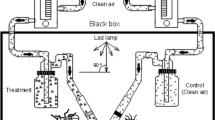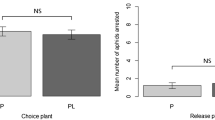Abstract
Mineral oil has been considered for several decades as an effective mean to control aphids and reduce the spread of non-persistent viruses. Mineral oil seems to reduce virus transmission efficiency interfering with the binding of the virions in the aphid stylets. However, several studies have shown the possible disruption of host selection process by mineral oil and some works have demonstrated a direct effect on the aphid vector. In this study the insecticidal properties of mineral oil (Finavestan EMA) alone against Macrosiphum euphorbiae (Thomas) (Homoptera: Aphididae) were evaluated through the three main routes of exposure (topical contact, inhalation and ingestion). Results showed that no aphid survived after topical contact at oil concentrations ranging from 3 to 100% v/v. However, surprisingly, at a lower concentration (0.3%), survival was not affected but fecundity was enhanced. Moreover, exposure to oil volatiles enhanced aphid survival at the highest concentrations (30 and 100%) and daily fecundity at the lowest ones (0.3 and 3%). Delivered via artificial diet, mineral oil only affected aphid survival at the 0.3% concentration. This study demonstrates that mineral oil alone, regardless of a potential plant effect can induce either probiotic effects or toxic effects, depending on the mode of application and the concentration tested. These results can be of significance for the understanding of mineral oil properties in the fields.



Similar content being viewed by others
References
Agnello AM (2001) Petroleum-derived spray oils: chemistry, history, refining and formulation. In: Beattie GAC, Watson DM, Stevens ML, Rae DJ, Spooner-Hart RN (eds) Spray oils beyond 2000. University of Western Sydney, pp 2–18
Ameline A, Couty A, Martoub M, Giordanengo P (2009) Effects of mineral oil application on the orientation and feeding behaviour of Macrosiphum euphorbiae (Homoptera: Aphidae). Acta Entomol Sin 52:617–623
Ameline A, Couty A, Martoub M, Sourice S, Giordanengo P (2010) Modification of Macrosiphum euphorbiae colonization behaviour and reproduction on potato plant treated by mineral oil. Entomol Exp Appl 135:77–84
Blackman RL, Eastop VF (2000) Aphids on the world’s crop: an identification and information guide, 2nd edn. Wiley, New York
Bradley RHE, Wade CV, Wood FA (1962) Aphid transmission of potato virus Y inhibited by oils. Virology 18:327–329
Bradley RHE, Moore CA, Pond CC (1966) Spread of potato virus Y curtailed by oil. Nature 209:1370–1371
Collar JL, Avilla C, Duque M, Fereres A (1997) Behavioral response and virus vector ability of Myzus persicae (Homoptera: Aphididae) probing on pepper plants treated with aphicides. J Econ Entomol 90:1628–1634
Down RE, Gatehouse AMR, Hamilton WDO, Gatehouse JA (1996) Snowdrop lectin inhibits development and decreases fecundity of the glasshouse potato aphid (Aulacorthum solani) when administrated in vivo and via transgenic plants both in laboratory and glasshouse trials. J Insect Physiol 42:1035–1045
Febvay G, Delobel B, Rahbé Y (1988) Influence of the amino acid balance on the improvement of an artificial diet for a biotype of Acyrtosiphon pisum (Homoptera: Aphididae). Can J Zool 66:2449–2453
Gibson RW, Rice AD (1986) The combined use of mineral oils and pyrethroids to control plant viruses transmitted non- and semipersistently by Myzus persicae. Ann Appl Entomol 109:465–472
Hildebrand DF, Brown GC, Jackson DM, Hamilton-Kemp TR (1993) Effects of some leaf-emitted volatile compounds on aphid population increase. J Chem Ecol 19:1875–1887
Hooks CRR, Fereres A (2006) Protecting crops from non-persistently aphid-transmitted viruses: a review on the use of barrier plants as a management tool. Virus Res 120:1–16
Kachroo P, Shanklin J, Shah J, Whittle EJ, Klessig DF (2001) A fatty acid desaturase modulates the activation of defense signaling pathways in plants. Proc Natl Acad Sci USA 98:9448–9453
Martin-Lopez B, Varela I, Marnotes S, Cabaleiro C (2006) Use of oils combined with low doses of insecticide for the control of Myzus persicae and PVY epidemics. Pest Manag Sci 62:372–378
Najar-Rodriguez AJ, Walter GH, Mensah RK (2007a) The efficacy of a petroleum spray oil against Aphis gossypii Glover on cotton. Part 1: mortality rates and sources of variation. Pest Manag Sci 63:586–595
Najar-Rodriguez AJ, Walter GH, Mensah RK (2007b) The efficacy of a petroleum spray oil against Aphis gossypii Glover on cotton. Part 2: indirect effects of oil deposits. Pest Manag Sci 63:596–607
Najar-Rodríguez AJ, Walter GH, Lavidis N, Mensah RK (2008) The toxicological effects of petroleum spray oils on insects—evidence for an alternative mode of action and possible new control options. Food Chem Toxicol 46:3003–3014
Powell G (1991) Cell membrane punctures during epidermal penetration by aphids: consequences for the transmission of two potyviruses. Ann Appl Entomol 119:313–321
Powell G (1992) The effect of mineral oil on stylet activities and potato virus Y transmission by aphids. Entomol Exp Appl 63:237–242
Powell G, Hardie J, Pickett JA (1998) The effects of antifeedant compounds and mineral oil on stylet penetration and transmission of potato virus Y by Myzus persicae (Sulz.) (Hom., Aphididae). J Appl Entomol 122:331–333
Simons JN, McLean DL, Kinsey MG (1977) Effects of mineral oil on probing behaviour and transmission of stylet-borne viruses by Myzus persicae. J Econ Entomo1 70:309–315
Tan BL, Sarafis V, Beattie G, White R, Darley E, Spooner-Hart R (2005) Localization and movement of mineral oil in plants by fluorescence and confocal microscopy. J Exp Bot 56:2755–2763
Vancanneyt G, Sanz C, Farmaki T, Paneque M, Ortego F, Castanera P, Sanchez-Serrano JJ (2001) Hydroperoxide lyase depletion in transgenic potato plants leads to an increase in aphid performance. Proc Natl Acad Sci USA 98:8139–8144
Wang RY, Pirone TP (1996) Mineral oil interferes with retention of tobacco etch potyvirus in the stylets of Myzus persicae. Phytopathology 86:820–823
Acknowledgments
The work was supported by the Ministère Français de la Recherche, the Comptoir Commercial des Lubrifiants and the Comité Nord Plants de Pommes de terre. We thank Y. Rahbé (INRA, Villeurbanne, France) for providing the M. euphorbiae clone and the Comité Nord Plants de Pommes de terre for providing the potato tubers. Andrew Roots is thanked for advice on the use of the English language in the paper.
Author information
Authors and Affiliations
Corresponding author
Additional information
Communicated by B. Freier.
Rights and permissions
About this article
Cite this article
Martoub, M., Couty, A., Giordanengo, P. et al. Opposite effects of different mineral oil treatments on Macrosiphum euphorbiae survival and fecundity. J Pest Sci 84, 229–233 (2011). https://doi.org/10.1007/s10340-010-0344-z
Received:
Accepted:
Published:
Issue Date:
DOI: https://doi.org/10.1007/s10340-010-0344-z




